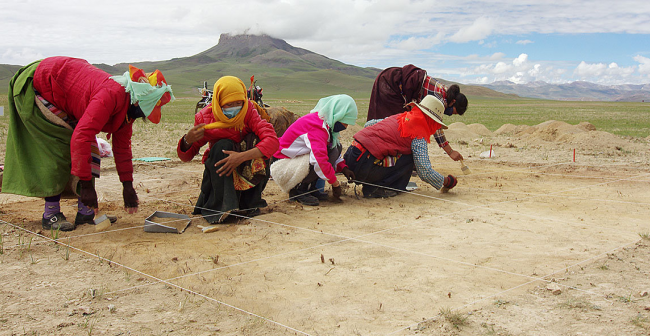
The Tibetan Plateau doesn’t seem like a very inviting place to live. At nearly three miles above sea level, the air is extremely thin. And yet, despite low temperatures, people have made this highland home—perhaps for tens of thousands of years.
Stone tools newly unearthed on the plateau could be the first evidence that people made a living there about 30,000 years ago. Archaeologists hadn’t found any sites older than 15,000 years old—until now.
The peopling of such a terrible environment is a story of human adaptability, and migration. At the time, there was no high-tech way to know whether the landscape over the next hill was poor or rich with resources without going there to check it out. Aldenderfer believes the idea that people were pulled to new places by following resources, not pushed there. “It’s still not a lovely place,” he says of the Tibetan Plateau. Humans at lower places near the Tibetan Plateau would’ve followed those familiar food resources up, and realized the high land wasn’t so bad. At the time, grasslands and other vegetation up there would have supported a range of animals.
But it’s not all about food at such high places, Aldenderfer says. “Deserts are hard to occupy and poles are hard, but the high-plateaus are hard in a different way,” he explains, referring to the added challenge of breathing at high altitudes. That’s where biology comes in. Tibetan highlanders today have a genetic trait that helps them breathe in enough oxygen that other humans don’t have.
本时文内容由奇速英语国际教育研究院原创编写,未经书面授权,禁止复制和任何商 业用途,版权所有,侵权必究!(投稿及合作联系:微信:13350077298 QQ:757722345)
1.What does the writer mainly want to tell us in Paragraph 1?
A The Tibetan Plateau isn’t suitable for people to live in.
B The air on the Tibetan Plateau is extremely thin.
C The temperatures on the Tibetan Plateau are very low.
D The long history of peopling on the Tibetan Plateau.
解析:选D。主旨大意题。根据第一段最后一句And yet, despite low temperatures, people have made this highland home—perhaps for tens of thousands of years.可知该段主要讲述的是尽管环境恶劣,人们依然选择居住在青藏高原,并且这一居住历史可能已经有几万年了。故选D。
2.How did people know there were people living on the plateau 30,000 years ago?
A They learned about the migration history.
B They studied the newly unearthed stone tools.
C They looked into the cold climate there.
D They went to live in the sites.
解析:选B。细节理解题。根据第二段第一句Stone tools newly unearthed on the plateau could be the first evidence that people made a living there about 30,000 years ago.可知人们是通过研究新出土的石器来得知3万多年以前就有人居住在青藏高原的。故选B。
3.What drove people to live on the Tibetan Plateau according to Aldenderfer?
A The terrible environment.
B The desire for searching new resources.
C The spirits of challenge.
D The fine and comfortable weather.
解析:选B。细节理解题。根据第三段第三句Aldenderfer believes the idea that people were pulled to new places by following resources, not pushed there. 可知他认为人们是为了追寻新资源才选择居住在青藏高原的。故选B。
4.Why can the Tibetan highlanders breathe well at high altitudes?
A They have a special genetic trait.
B They have lived in such high places for long.
C They eat much more vegetation.
D They often live on familiar foods.
解析:选A。细节理解题。根据最后一段第四句Tibetan highlanders today have a genetic trait that helps them breathe in enough oxygen that other humans don’t have.可知是青藏高原上人们的基因特征使他们在高海拔地区能够很好地呼吸的。故选A。